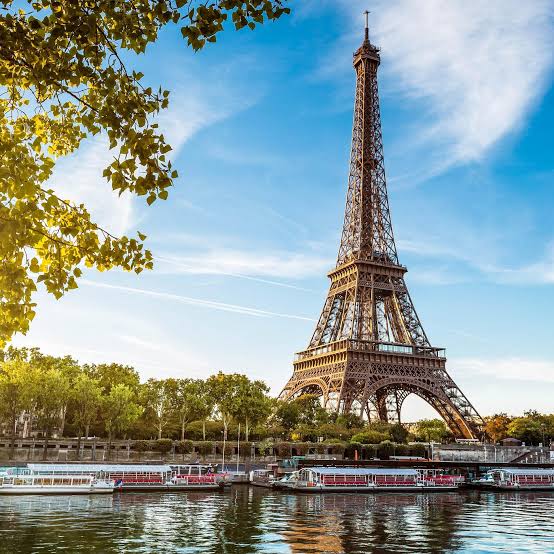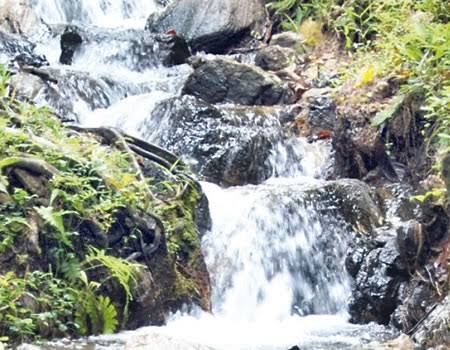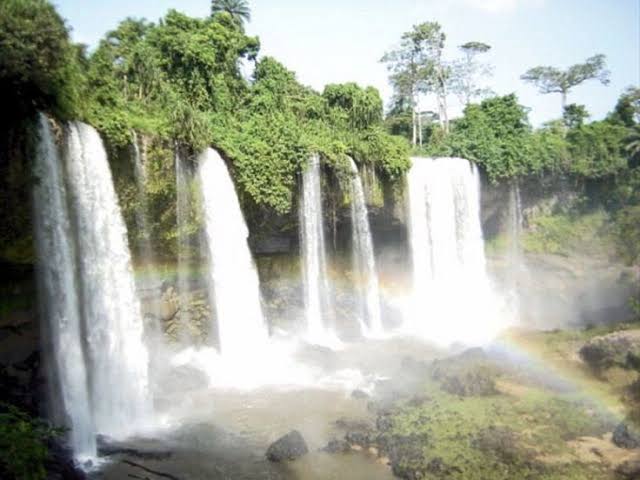Location & how to get there: Ikogosi Warm Spring sits in Ikogosi-Ekiti, Ekiti State (South-West Nigeria), roughly 25–30 km from Ado-Ekiti, the state capital. It’s reachable by road via Ado-Ekiti → Igbara-Odo → Ikogosi or via Aramoko/Erio. Within the landscaped reserve you’ll find marked footpaths through secondary rainforest, interpretation boards, and the confluence where the phenomenon is most visible.
What makes it unique (and how it formed): Ikogosi is famous for two natural springs—one warm, one cold—flowing side by side and meeting at a confluence while each stream largely retains its temperature. Measurements widely reported put the warm spring at ~70 °C at source and ~37 °C where it meets the cold stream. Geophysical work in the area points to deep-seated fractures in hard metamorphic rocks and a relatively high geothermal gradient, which together help explain groundwater heating and the persistence of different temperatures at shallow depth.
Local folklore offers a poetic “origin” too: In some tellings, the warm and cold streams represent a quarrelling couple reconciled in unity—one fiery, one cool—meeting without losing their nature. This cultural layer is part of what keeps the site spiritually resonant for residents and visitors alike.
The Significance: Scientific/educational: A natural field lab for hydrology, geothermal studies, and environmental science students. Recent studies model heat flow and fracture-controlled aquifers around Ikogosi.
Cultural: A place of local myths, festivals, and community memory; it features in Ekiti’s identity and tourism branding.
Recreational/wellness: Gentle walking, nature photography, and resort-based relaxation; historically, some visitors have ascribed therapeutic value to soaking or rinsing in the warm stream. (As with any spring, therapeutic claims are anecdotal rather than clinical.)
Tourism potentialities (what to do & nearby add-ons): Confluence walk: Follow paved paths to the meeting point of the warm and cold streams; lingering mist and rock pools make for striking photos.
Nature trails: Forested walkways with interpretive signs; birdlife and butterflies are common after rains.
Resort experience: On-site rooms, conference facilities, pool, and curated activities have been significantly upgraded in recent years under private management.
Clustered attractions: Combine with Arinta Waterfalls at Ipole-Iloro (a short drive) and other Ekiti eco-spots to build a compelling weekend circuit. (State tourism materials often package these together.)
Economic impact (current & emerging): Ikogosi has long been one of Ekiti’s flagship attractions. Recent revitalisation of the resort and grounds—including new management, refurbishments and programming—has reignited visitor inflows, jobs for guides, gardeners, housekeeping, drivers, and small-business vendors, and has boosted internally generated revenue (IGR) through gate fees, lodging, meetings, and events. Coverage in national media highlights the site’s role in eco-tourism and business retreats, and the resort has picked up national recognition since its post-2022 turnaround.
Longer-term upside sits in: Meetings & incentives (MICE): Retreats and conferences that keep mid-week occupancy high.
Local value chains: Produce supply to kitchens, crafts, transport, and guided experiences.
Research & training: Field schools and short courses in environmental science and hospitality management.
Environment & ecology: The springs run through secondary rainforest with riparian vegetation stabilising banks and shading the channels, which in turn helps temperature stratification persist along short reaches. Paths and gabions manage erosion on popular sections. Responsible visitation (stay on paths; no littering; avoid soap/shampoo in the stream) protects water quality and wildlife. Academic and government notes emphasise that regenerative landscape design—replanting, careful hardscaping, and visitor flow management—supports both conservation and guest experience.
Prospects (“prosperities”): What could make Ikogosi even better: Deeper interpretation: A small geothermal & culture interpretation centre with hands-on exhibits (heat flow, rock cores, folklore listening stations).
Wellness programming: Evidence-based hydrotherapy circuits (warm rinse–cool plunge) with proper safety and medical disclaimers.
Data-driven stewardship: Ongoing water quality, discharge, and temperature logging to manage carrying capacity and seasonality.
Community-led enterprises: Structured vendor cooperatives for souvenirs, guides, and food, to keep more revenue local.
Regional branding: Joint passes and shuttle links with Arinta Falls and other Ekiti sights to lengthen stays.
These directions align with recommendations from recent ecotourism landscape regeneration studies focused on Ikogosi.
Merits vs. demerits (honest look)
Merits
1. Singular natural phenomenon: Twin springs at contrasting temperatures meeting visibly—a rarity that’s easy to explain and market.
2. All-season appeal: Flow is perennial; rainforest shade moderates heat for year-round visits.
3. Improved visitor infrastructure: Renovated resort and grounds, growing calendar of retreats and events.
Demerits / constraints
1. Maintenance sensitivity: Tropical vegetation and heavy rains mean paths, signage, and drainage need constant upkeep; past neglect shows how quickly assets can deteriorate.
2. Access variability: Road quality and transport options can affect trip comfort, especially in peak rainy months. (General regional travel constraint.)
3. Myth vs. medicine: Wellness lore attracts visitors, but unverified therapeutic claims should not be marketed as medical treatment; water quality must be routinely tested.
Practical visitor notes
Hours & fees: The park is typically open daily in daytime hours with a modest gate fee; rates and opening times vary by management and season—always check the resort or state tourism page before you go.
Best time: Dry season (Nov–March) offers the clearest trails; rainy months are greener and photogenic but can be slippery.
What to bring: Grippy walking shoes, light rain jacket, insect repellent, water, and a camera.
Etiquette: Stay on paths, respect cultural markers, and avoid contaminating the streams.
A short history in the modern era: Although known to locals for generations, Ikogosi’s modern development gained momentum in the mid-20th century, when interest grew in formalising access and building camp facilities. Government and private efforts over the decades produced guest chalets and a pool area, followed by periods of decline and then renewed investment in the 2010s–2020s, culminating in the recent revitalisation of the Ikogosi Warm Springs Resort & Conference Centre.
Botom line: Ikogosi blends geology, ecology, and culture into a concise, photogenic experience that’s easy to recommend: a cool-warm confluence you can actually stand beside, with improving facilities and strong upside for local livelihoods—so long as careful stewardship keeps the springs clean, the forest healthy, and the story authentic.






